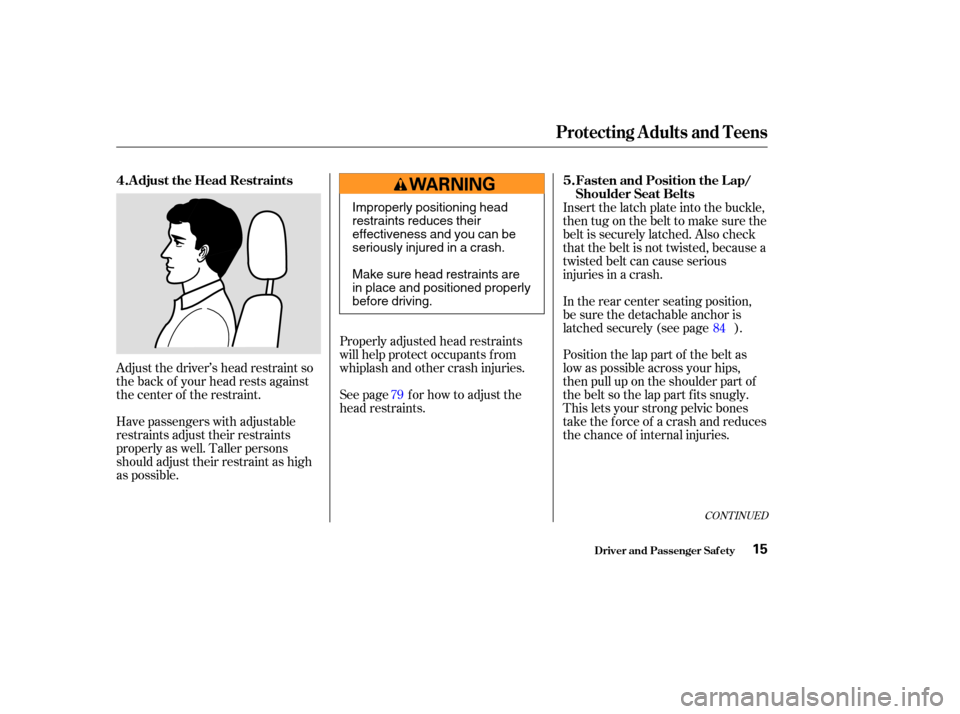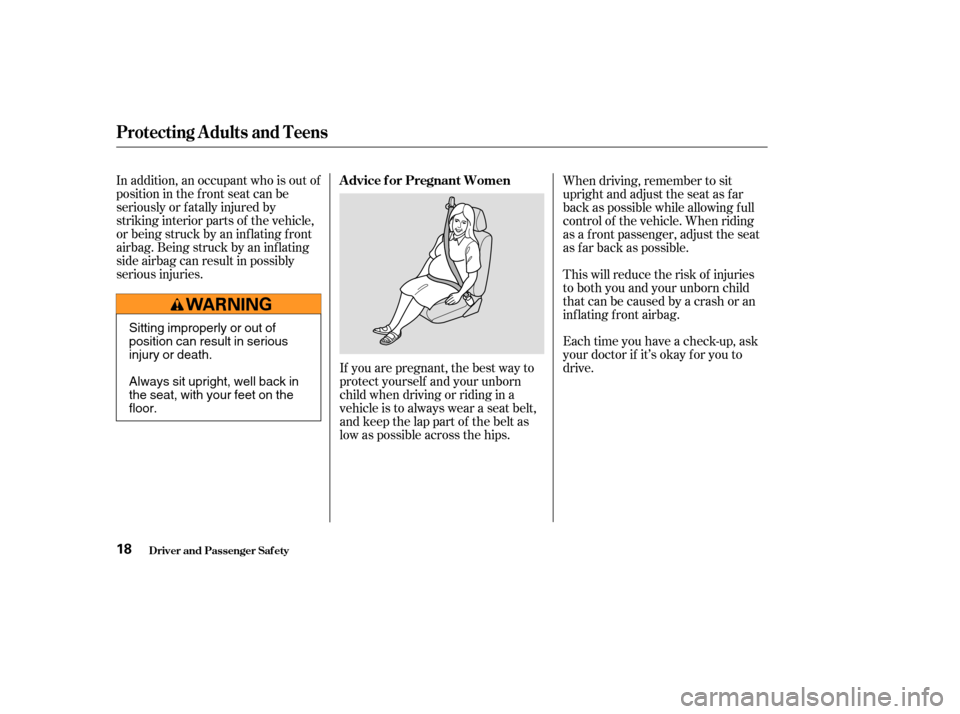Page 15 of 256
Always wear your seat belt properly,
sit upright, and as far back from the
steering wheel while allowing f ull
control of the vehicle. A f ront
passenger should move their seat as
f ar back f rom the dashboard as
possible.
Your Vehicle’s Saf ety Features
Driver and Passenger Saf ety
What You Should Do:
11
Page 16 of 256

Af ter everyone has entered the
vehicle, be sure the doors are closed
and locked.If you sit too close to the steering
wheel or dashboard, you can be
seriously injured by an inf lating f ront
airbag, or by striking the steering
wheel or dashboard.
See page f or important guidelines
on how to properly protect inf ants,
small children, and larger children
who ride in your vehicle. The f ollowing pages provide
instructions on how to properly
protect the driver, adult passengers
and teenage children who are large
enough and mature enough to ride in
the front seat. Remember however, that no saf ety
system can prevent all injures or
deaths that can occur in severe
crashes, even where seat belts are
properly worn and the airbags deploy. The rest of this section gives more
detailed inf ormation about how you
can maximize your saf ety.
Locking the doors reduces the
chance of someone being thrown out
of the vehicle during a crash, and it
helps prevent passengers f rom
accidentally opening a door and
f alling out.
Adjust the driver’s seat as far to the
rear as possible while allowing you to
maintain control of the vehicle. Have
a f ront passenger adjust their seat as
far to the rear as possible.
Locking the doors also helps prevent
an outsider f rom unexpectedly
opening a door when you come to a
stop.
See page f or how to lock the
doors.
36 72
Protecting A dults and Teens
Driver and Passenger Saf ety
Close and L ock the Doors
A djust the Front Seats
Introduction 1.2.
12
Page 17 of 256
The National Highway Traffic Safety
Administration and Transport
Canada recommend that drivers
allow at least 10 inches (25 cm)
between the center of the steering
wheel and the chest.
If you cannot get f ar enough away
f rom the steering wheel and still
reach the controls, we recommend
that you investigate whether some
type of adaptive equipment may help.Once your seat is adjusted correctly,
rock it back and f orth to make sure
the seat is locked into position. See
page f or how to adjust the f ront
seats.
77
Protecting A dults and Teens
Driver and Passenger Saf ety13
Sitting too close to a front
airbag can result in serious
injury or death if the front
airbags inflate.
Always sit as far back from the
front airbags as possible.
Page 18 of 256
Adjust the driver’s seat-back to a
comf ortable, upright position,
leaving ample space between your
chest and the airbag cover in the
center of the steering wheel.
Passengers with adjustable seat-
backs should also adjust their seat-
back to a comf ortable, upright
position.Reclining a seat-back so that the
shoulder part of the belt no longer
rests against the occupant’s chest
reduces the protective capability of
the belt. It also increases the chance
of sliding under the belt in a crash
and being seriously injured. The
farther a seat-back is reclined, the
greater the risk of injury.
See page f or how to adjust seat-
backs.
77
Protecting A dults and Teens
Driver and Passenger Saf ety
Adjust the Seat-Backs
3.
14
Reclining the seat-back too far
can result in serious injury or
death in a crash.
Adjust the seat-back to an
upright position, and sit well
back in the seat.
Page 19 of 256

Adjust the driver’s head restraint so
the back of your head rests against
the center of the restraint.
Have passengers with adjustable
restraints adjust their restraints
properly as well. Taller persons
should adjust their restraint as high
as possible.Properly adjusted head restraints
will help protect occupants f rom
whiplash and other crash injuries.
See page f or how to adjust the
head restraints.Insert the latch plate into the buckle,
then tug on the belt to make sure the
belt is securely latched. Also check
that the belt is not twisted, because a
twisted belt can cause serious
injuries in a crash.
Position the lap part of the belt as
low as possible across your hips,
then pull up on the shoulder part of
thebeltsothelappartfitssnugly.
This lets your strong pelvic bones
take the force of a crash and reduces
the chance of internal injuries. In the rear center seating position,
be sure the detachable anchor is
latched securely (see page ).
79 84
CONT INUED
Protecting A dults and Teens
Driver and Passenger Saf ety
Adjust the Head Restraints
Fasten and Position the Lap/
Shoulder Seat Belts
4.
5.
15
Improperly positioning head
restraints reduces their
effectiveness and you can be
seriously injured in a crash.
Make sure head restraints are
in place and positioned properly
before driving.
Page 20 of 256
If necessary, pull up on the belt again
to remove any slack, then check that
the belt rests across the center of
your chest and over your shoulder.
This spreads the f orces of a crash
over the strongest bones in your
upper body.If the seat belt touches or crosses
your neck, or if it crosses your arm
instead of your shoulder, you need to
adjust the seat belt anchor height.
To adjust the height of a f ront seat
belt anchor, press and hold the
release button and slide the anchor
up or down as needed (the anchor
has f our positions).This could cause
very serious injuries in a crash.
Protecting A dults and Teens
Driver and Passenger Saf ety
Never place t he shoulder port ion of a
lap/shoulder belt under your arm orbehind your back.
16
RELEASE BUTTONS
Improperly positioning the seat
belts can cause serious injury
or death in a crash.
Make sure all seat belts are
properly positioned before
driving.
Page 21 of 256

If a seat belt does not seem to work
as it should, it may not protect the
occupant in a crash.Using a seat
belt that is not working properly can
result in serious injury or death.
Have your Honda dealer check the
belt as soon as possible.
See page f or additional
inf ormation about your seat belts
and how to take care of them. Adjust the steering wheel, if needed,
so that the wheel points toward your
chest, not toward your f ace. This
provides optimal protection f rom the
f ront airbag.
See page f or how to adjust the
steering wheel.After all occupants have adjusted
their seats and put on seat belts, it is
very important that they continue to
sit upright, well back in their seats,
with their feet on the floor, until the
vehicle is parked and the engine is
of f .
Sitting improperly can increase the
chance of injury during a crash. For
example, if an occupant slouches,
lies down, turns sideways, sits
forward, leans forward or sideways,
or puts one or both f eet up, the
chance of injury during a crash is
greatly increased.
20
68
CONT INUED
Protecting A dults and Teens
Driver and Passenger Saf ety
No one should sit in a seat wit h aninoperat ive seat belt .
Adjust the Steering Wheel Maintain a Proper Sitting
Position
6.
7.
17
Page 22 of 256

In addition, an occupant who is out of
position in the f ront seat can be
seriously or f atally injured by
striking interior parts of the vehicle,
or being struck by an inf lating f ront
airbag. Being struck by an inflating
side airbag can result in possibly
serious injuries.If you are pregnant, the best way to
protect yourself and your unborn
child when driving or riding in a
vehicle is to always wear a seat belt,
and keep the lap part of the belt as
low as possible across the hips.When driving, remember to sit
upright and adjust the seat as f ar
back as possible while allowing f ull
control of the vehicle. When riding
as a f ront passenger, adjust the seat
as far back as possible.
This will reduce the risk of injuries
to both you and your unborn child
that can be caused by a crash or an
inflating front airbag.
Each time you have a check-up, ask
your doctor if it’s okay f or you to
drive.
Protecting A dults and Teens
Driver and Passenger Saf ety
Advice f or Pregnant Women
18
Sitting improperly or out of
position can result in serious
injury or death.
Always sit upright, well back in
the seat, with your feet on the
floor.